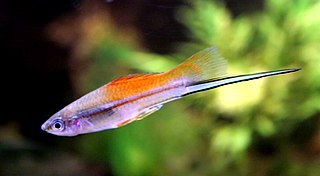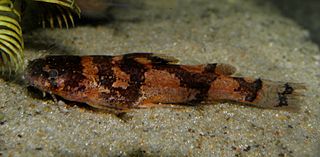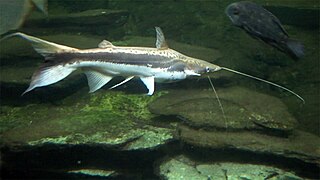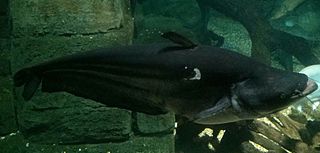
The Chao Phraya is the major river in Thailand, with its low alluvial plain forming the centre of the country. It flows through Bangkok and then into the Gulf of Thailand.

The hillstream loaches or river loaches are a family, the Balitoridae, of small fish from South, Southeast and East Asia. The family includes about 202 species. They are sometimes sold as "lizardfish" or "flossensaugers". Many of the species are popular for aquaria, species in the genus Sewellia are most commonly sold in the aquaria trade. They have a number of similarities with the Cobitidae, their sibling family of "loaches", such as multiple barbels around the mouth. They should not be confused with the loricariids, which look similar but are a family of catfish.

The Amazon Basin is the part of South America drained by the Amazon River and its tributaries. The Amazon drainage basin covers an area of about 6,300,000 km2 (2,400,000 sq mi), or about 35.5 percent of the South American continent. It is located in the countries of Bolivia, Brazil, Colombia, Ecuador, French Guiana (France), Guyana, Peru, Suriname, and Venezuela.

Xiphophorus is a genus of euryhaline and freshwater fishes in the family Poeciliidae of order Cyprinodontiformes, native to Mexico and northern Central America. The many Xiphophorus species are all called either platyfish or swordtails. The type species is X. hellerii, the green swordtail. Like most other new world Poeciliids, platies and swordtails are live-bearers that use internal fertilization and give birth to live young instead of laying eggs like the bulk of the world's fishes. The name Xiphophorus derives from the Greek words ξίφος (dagger) and φόρος (bearer), referring to the gonopodium on the males. All are relatively small fishes, which reach a maximum length of 3.5–16 cm (1.4–6.3 in) depending on the exact species involved.

Hypostomus is a genus of catfish in the family Loricariidae. They are native to tropical and subtropical South America. H. plecostomus is the popular freshwater aquarium fish formerly known as Plecostomus plecostomus. There is a lot of confusion as to the precise taxonomic structure of the Loricariidae.

The Kapuas River is a river in the Indonesian part of Borneo island, at the geographic center of Maritime Southeast Asia. At 1,143 kilometers (710 mi) in length, it is the longest river of Indonesia and one of the world's longest island rivers. It originates in the Müller mountain range at the center of the island and flows west into the South China Sea creating an extended marshy delta. The delta is located west-southwest of Pontianak, the capital of the West Kalimantan province. This Kapuas River should be distinguished from another Kapuas River, which starts on the other side of the same mountain range in central Borneo, but flows to the south, merging with the Barito River and discharging into the Java Sea.

Wallago is a genus of catfishes order Siluriformes of the family Siluridae, or sheatfish. They are found in rivers throughout southern and southeastern Asia. The only extant species of this genus is Wallago attu.

Wallago attu is a freshwater catfish of the family Siluridae, native to South and Southeast Asia. It is commonly known as helicopter catfish or wallago catfish. Some regional designations, such as the Manipuri Sareng, the Bengal Boal, the Sylheti Gual or the Malaysian and Indonesian Tapah are also occasionally used in English. W. attu is found in large rivers and lakes in two geographically disconnected regions, with one population living over much of the Indian Subcontinent and the other in parts of Southeast Asia. The species can reach a total length of 1 m.

Siluridae is the nominate family of catfishes in the order Siluriformes. About 105 living species of silurids are placed in 14 genera.

Microglanis is a genus of fish in the family Pseudopimelodidae native to South America. This genus has the widest distribution within its family, with species ranging from the Guianas to Venezuela; western slope of the Andes in Ecuador and Peru to the Río de La Plata basin in Argentina. They occur eastward to the Orinoco and Amazon basins. It is also present in the eastern coastal rivers of Brazil.

Sorubim is a small genus of long-whiskered catfish native to tropical South America. A number of characteristics allows the differentiation of each species in the genus. Sorubim species are important food fish in South America and are highly significant to fisheries of some areas; however, harvests of these fish are not identified as much as other, more popular food fishes such as Colossoma, Arapaima, and Brachyplatystoma. Some species of this family are popular aquarium fish.

Wallagonia micropogon is a species of catfish in the genus Wallagonia. This species was recently discovered and is found in the Mekong River drainage area between southern Vietnam and northern Laos as well as Chao Phraya River in Thailand. It is a freshwater fish.

Hemibagrus is a genus of catfishes of the family Bagridae.
Leiocassis is a genus of bagrid catfishes found mostly in Southeast Asia with some species occurring in China.
Parastegophilus is a genus of pencil catfishes native to South America.
Parakysis is a genus of catfishes of the family Akysidae. It includes six species.

Psilorhynchus is a genus of fish in the family Psilorhynchidae native to South Asia. This genus is the only member of its family. The members of Psilorhynchus are small benthic fishes which occur in rivers and streams with fast to swift currents, hence they are often referred to a torrent minnows. They are distributed in southern Asia, in the Indo-Burma region and the Western Ghats. The genus is the sister group to the family Cyprinidae, and with that family the Psilorhynchidae makes up the superfamily Cyprinoidea, with all the other cypriniform families in the superfamily Cobitoidea.

Bagarius yarrelli, also known as the giant devil catfish or goonch, is a very large species of catfish in the genus Bagarius found in rivers in the Indian subcontinent. It is likely synonymous with B. bagarius.
Wallagonia maculatus is a species of catfish in the family Siluridae endemic to Malaysia, where it is known only from Sabah in northern Borneo. This species grows up to a length of 100 centimetres (39 in) SL.

Wallagonia leerii, also known as the striped wallago catfish, helicopter catfish, or Tapah is a species of catfish native to Southeast Asia. Its habitat ranges from the river drainages of Thailand through the Malayan peninsula to the islands of Sumatra and Borneo in Indonesia. It can grow up to 2 m in length and weigh up to 95 kg (209 lb). It has been used as food in Southeast Asia since ancient times.
















